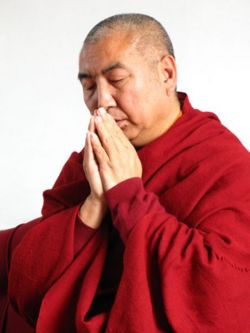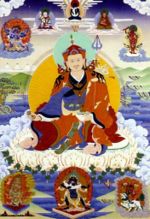Main Page: Difference between revisions
Jump to navigation
Jump to search
(Main Page moved to Rigpa Shedra Wiki) |
No edit summary |
||
| Line 1: | Line 1: | ||
# | [[Image:Khenpo Namdrol prayer.jpg|thumb|250px|[[Khenchen Namdrol]], who oversees the Rigpa Shedra in Nepal]] | ||
{| style="width:280px; border:none; background:none;" | |||
| style="width:280px; text-align:center; white-space:nowrap; color:#000;" | | |||
<div style="font-size:162%; border:none; margin:0; padding:.1em; color:#000;">Welcome to the [[Rigpa Shedra]] Wiki,</div> | |||
<div style="top:+0.2em; font-size:95%;">an online encyclopedia of ''[[Tibetan Buddhism]]</div> | |||
<div id="articlecount" style="width:100%; text-align:center; font-size:85%;">We currently have [[Special:Statistics|{{NUMBEROFARTICLES}}]] articles</div> | |||
|} | |||
You can '''search the site''' using the upper ''search'' box to the left. A second ''Google Custom Search'' box can be used for searching related sites in addition to this one. Additionally you can select from some of the '''main categories''' included in the encyclopedia: | |||
:*[[:Category:Buddhas_and_Deities|Buddhas & Deities]] | |||
:*[[:Category:Enumerations|Enumerations]] | |||
:*[[:Category:Contemporary_Teachers|Contemporary Teachers]] | |||
:*[[:Category:Historical_Masters|Historical Masters]] | |||
:*[[:Category:Prayers_and_Practices|Prayers & Practices]] | |||
:*[[:Category:Schools_and_Lineages|Schools & Lineages]] | |||
:*[[:Category:Texts|Texts]] | |||
You might also want to subscribe to the '''recent changes''' to keep track of all the additions to the site as they happen. | |||
:*[[special:Recentchanges|Recent changes]] | |||
*''If you are new to Wikis, consult the [[Help]] page.'' <br> | |||
==Featured Pages== | |||
{| class="wikitable" style="color:black;background-color:#f4f4f4;" cellspacing="5" border="0" text-align:left,bottom" | |||
|+ | |||
|- | |||
| [[Image:Guru rinpoche.jpg|150px]] || style="background-color:#f7f7f7" cellpadding="5" | | |||
*'''[[Padmasambhava]]''' (Skt.), or '''Padmakara''' (Skt. ''Padmākara''; Tib. ''Pemajungné''; [[Wyl.]] ''pad+ma 'byung gnas'') means ‘Lotus-Born’, which refers to Guru Rinpoche's birth from a lotus in the land of [[Oddiyana]]. '''Guru Rinpoche''', the ‘Precious Master’, is the founder of [[Tibetan Buddhism]] and the [[Buddha]] of our time. Whereas Buddha is known primarily for having taught the teachings of the [[sutra]] vehicle, Padmasambhava came into this world, and to Tibet in particular, in order to teach the [[tantra]]s. While [[Buddha Shakyamuni]] exemplifies the buddha principle, the most important element in the [[sutrayana]] path, Padmasambhava personifies the [[guru]] principle, the heart of [[Vajrayana]] Buddhism, and he is therefore known as the ‘second Buddha’ (Tib. ''sangyé nyipa''). ([[Padmasambhava|Read more...]]) | |||
*[[Shedra MP3 Library]] | |||
|} | |||
Revision as of 13:32, 7 August 2009

|
Welcome to the Rigpa Shedra Wiki,
an online encyclopedia of Tibetan Buddhism
We currently have 11,507 articles
|
You can search the site using the upper search box to the left. A second Google Custom Search box can be used for searching related sites in addition to this one. Additionally you can select from some of the main categories included in the encyclopedia:
You might also want to subscribe to the recent changes to keep track of all the additions to the site as they happen.
- If you are new to Wikis, consult the Help page.
Featured Pages
 |
|